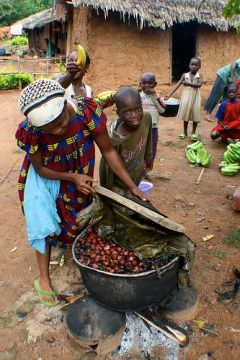Non-timber Forest Products and the Role of Markets for Community Adaptation

Tropical forests provide many non-timber products (NTFPs) such as, charcoal, wild fruit, bushmeat, mushrooms, roots and fodder, used by numerous communities around the globe for income diversification and also as safety nets during times of resource scarcity and disaster. Medicinal plants are also widely used to cure a wide range of ailments (e.g. back pain, cold, diarrhea, malaria, measles, rheumatism, worms, etc.), especially in cases when income for the purchase of pharmaceutical products is lacking.
When crops fail due to drought in Africa, the poorer communities supplement their income by selling wild fruits, firewood and charcoal. They also supplement their food intake by consuming wild fruits and vegetables directly. In rural areas of Central and South America, the gathering of forest fruits, palm hearts and other products constitutes an important strategy for coping with flood shock for the young and less-fortunate households that do not have land or rich fish stocks nearby.

Photo by Terry Sunderland/CIFOR
Low-income households close to the forests turn to them in times of misfortune for several reasons. Forest products are freely available to local communities, as forests are often under state or communal tenure. They are also more accessible for the poorer people as harvesting them usually requires limited financial, physical or human capital. Furthermore, forest resources are often available when other income sources are not, helping households to avoid starvation when disaster strikes.
The poorest of the poor might turn to the forest during or after a disaster in order to survive, but many people in tropical regions also use forest and tree products as an integral income diversification strategy for dealing with climate variability on a constant basis. Households in Tanzania for example, use firewood, fruits, spices, fodder, traditional medicines and meat, and also harvest trees for the production of timber, charcoal and bricks sold mainly to the capital Dar es Salaam. Rural communities of the Congo Basin use the forests extensively for subsistence and livelihoods and also to cope with climate variability related to the start and duration of the rainfall seasons. Charcoal represents the largest and most frequent removal of goods from the ecosystem, closely followed by goods for the production of palm wine. Gathering of NTFPs such as caterpillars and mushrooms is practiced frequently for both trade and direct consumption due to their role as dietary sources of protein.
The same forest goods are increasingly surrounded by emerging markets linking the usually remote communities with major urban centers nationally and internationally. But what is the effect of these markets on the adaptive capacity of forest-dependent and local people?
Does market integration make people more resilient to different shocks due to an increased revenue stream from selling NTFPs and the decreased dependence on climate-sensitive annual crops? Will the intensification of NTFP marketing as an adaptation strategy be beneficial for local communities and supersede or substitute their direct use of forest resources as safety nets?
The answer is, as always, it depends.
CIFOR research in the Congo Basin has shown that the distribution of the market revenue leaves local people with returns much lower than the worth of the NTFP commodities, while wholesalers and retailers reap most of the benefits and profit. Markets increase the value of commodities but their contributions to adaptation appear highly limited for local communities following their distribution among the stakeholders in the market chain. The situation is worse when markets diminish the safety net roles of forest goods and services.
External interests or local elites have a tendency to capture a disproportionate share of the benefits from the sale of NTFPs once their value is recognized, or once infrastructural development facilitates traders’ access to previously remote communities. In some cases, communities are even denied access to the resource and consequently they lose important safety nets.
Potential externalities for other aspects of human well-being should also be considered. CIFOR research has shown how the commercialization of nuts, mushrooms, vegetables, and other food products from forests could have a negative effect on health, as rural communities shift from diets rich in fibre and micro-nutrients to processed foods. Money generated by the sale of these foods — which can provide a significant portion of micro-nutrients consumed — is often used to buy processed foods high in calories, fat and refined sugar and low in micro-nutrients. Appropriate and timely education about nutrition should be employed at the same time as programmes designed to generate income.
There are however many positive examples to be found, especially under fair trade and other certification schemes. Fair trade schemes in Africa for shea nuts for example have not only increased the value of the commodity and the revenue that producers get from it, but have also lead to capacity building and better shea tree management. Eco-certification schemes for rattan have had the same impact in Asia.
Ultimately, markets should complement rather than substitute forests roles for adaptation to climate change in tropical forest countries. Capturing the benefits of trade for adaptation is crucial but will require policy reforms and further research that addresses the complexity in benefit sharing.
(0) Comments
There is no content